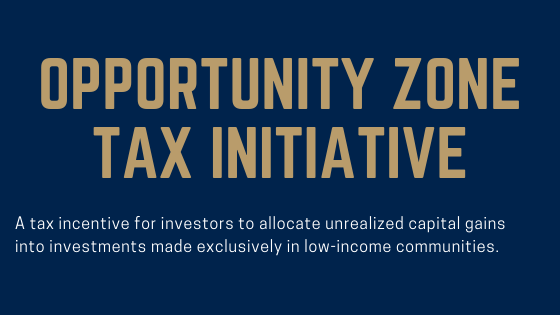The Tax Cuts and Jobs Act created a new avenue for community investment with the Opportunity Zone Tax Initiative. The initiative looks to spark economic recovery in targeted areas of the country, taking aim at $6.5 trillion in unrealized capital gains estimated to be in the market.
Investors can defer payment of gains, reduce what they owe if the investment is held for a certain period, and pay zero tax on the growth of those investments if the investment is maintained for a minimum of 5 years.
Through the program investors can reinvest unrealized capital gains into Opportunity Funds, an investment vehicle set up as a partnership or corporation for investing in eligible businesses, real estate, or business assets. Thus far, the IRS has offered compliance guidelines but seems to be trusting the will of investors and not imposing strict government oversight.
How it Works
The Opportunity Zones program offers three tax benefits for investing in low-income communities through a qualified Opportunity Fund:
- A temporary deferral of taxation on realized capital gains reinvested in an Opportunity Fund.
- An increase in basis for an original investment put in an Opportunity Fund. The basis increase is based on the number of years the investment is held, with a 10% discount on capital gains tax if the investment is held for 5 years and a 15% discount if held for 7 years. To take advantage of the 15% discount, an investment into an Opportunity Fund must be made by December 31, 2019.
- An exclusion from tax on the ultimate sale of the new investment if the investment is held for at least 10 years.
Download a list of Qualified Opportunity Zones from the U.S. Department of Treasury, certified as of June 14, 2018 or, view the zones on an interactive map.
What is an Opportunity Zone? 
Opportunity zones are defined as areas either below 80% of the median income or have a higher than 20% poverty rate, as shown in the most recent census numbers. The zones were nominated by governors and certified by the U.S. Department of Treasury.
According to the Economic Innovation Group (EIG), 52.3 million Americans live in economically distressed communities, or areas struggling to bring in capital and new investors. EIG also found that the country is dependent upon only a handful of areas for its growth, and most metro areas are seeing businesses close rather than open each year.
Qualified Opportunity Zone investment properties include newly issued stock, partnership interests, and business property in a qualified Opportunity Zone business.
What are Opportunity Funds?
Opportunity funds are a private sector investment fund that puts at least 90% of its capital into Opportunity Zones. In addition, 50% of the revenue in the fund must come from a zone investment. The fund model allows for investors to pool resources and enjoy tax benefits, while simultaneously making an investment into underserved communities.
Opportunity funds must be organized as a corporation or partnership, but the guidelines allow for a broad participation from many different types of investors. In addition, the fund can invest across multiple Opportunity Zones or just one zone.
What could an investment look like?
Situation Overview
- In 2018, an individual investor sells 1,000 shares of Amazon stock that they purchased in 2013 for $250,000.
- The sale at $1,250 per share results in a $1 million capital gain.
- Instead of paying the $238,000 in federal capital gains tax on this sale, the investor rolls their $1 million gain into a Qualified Opportunity Fund that invests the capital in newly issued preferred stock shares of various operating businesses located in Opportunity Zones with a plan to liquidate the fund in 2028.
- The assumed value of this investment in 2028 is $2 million.
Investor Benefits Include:
- Investing $1 million instead of the $762,000 that would be remaining if the capital was not re-invested into an Opportunity Fund.
- Paying $202,300 in taxes in 2026 instead of paying $238,000 in 2018.
- Owing no additional tax on the $1 million in capital gains on the Opportunity Fund investment realized in 2028.
How do I invest?
It’s important to engage in a conversation with your experts early. To qualify as an Opportunity Zone investment, the money must be put into an Opportunity Fund within 180 days of the sale of the original investment. That tight turn around time doesn’t leave a lot of room for research into a new long-term investment that will yield revenue.
A financial advisor can help identify which properties to sell to make an investment as well as identify the risks of a new investment into a fund. Investing in existing opportunity funds works similarly to forming a partnership, so working with an attorney and an accountant will help smooth the road ahead. Since the IRS has offered broad guidelines for the initiative, connecting with experts early will likely save potential headaches in the future.
What’s the catch?
The IRS has rolled out few guidelines to govern this new initiative, which means this is uncharted territory. A lack of structure could lead to audits down the road, but engaging an experienced CPA early in your investment process will limit that possibility.
A misstep beyond the guidelines could trigger penalties, or a retroactive gains tax bill on your original investment. In addition, unless Congress decided to extend the program beyond its 10-year run, investors need to make sure there is liquidity to the fund to pay any taxes due in 2027.
Some restrictions offered by the IRS also state that no portion of the proceeds from the fund can be used to provide (including land) any private or commercial golf course, country club, massage parlor, hot tub facility, suntan facility, racetrack or other gambling facility, or any store with a principal business in the sale of alcohol for consumption off premises.

A tax partner, Richard A. Fragale, CPA, MT, provides tax planning and consultation services to closely held and middle market business and not-for-profit organizations in the healthcare, professional services, retail, real estate, and construction industries. He advises high net worth individuals and families in the areas of estate planning, trust planning, and gifting strategies. Read more



